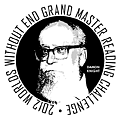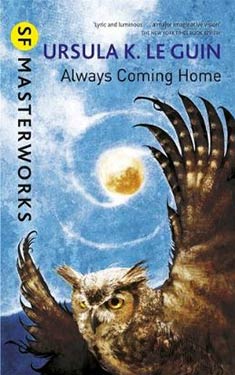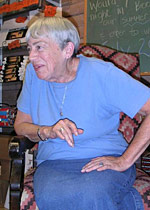GMRC Review: Always Coming Home by Ursula K. Le Guin
 Scott Lazerus came to Worlds Without End looking for a good list of books. He found David Pringle’s Best 100 Science Fiction Novels to his liking and is currently working his way through the list. He has posted man fine reviews for WWEnd including several for the GMRC. Be sure to check out Scott’s excellent blog series Forays into Fantasy too!
Scott Lazerus came to Worlds Without End looking for a good list of books. He found David Pringle’s Best 100 Science Fiction Novels to his liking and is currently working his way through the list. He has posted man fine reviews for WWEnd including several for the GMRC. Be sure to check out Scott’s excellent blog series Forays into Fantasy too!
 To borrow from the title of one of the first sections of Always Coming Home, this book is an “archaeology of the future.” I purposely use the term book rather than novel, since the structure of Ursula K. Le Guin‘s 1985 work makes it more of a collage than a narrative, though it does tell a story, and it certainly has a theme. The story is that of an entire people—the Kesh, the People of the Valley, living in the far distant future somewhere in Northern California. A changed climate has created an inland sea east of the Valley, and the people who live there are still dealing with the legacy of the chemical wastes left behind by a long-gone civilization whom the Kesh think of as people “who lived outside the world” and whose poisonous lifestyle has led to their being remembered in legends and visions as people who (literally) had their heads on backwards.
To borrow from the title of one of the first sections of Always Coming Home, this book is an “archaeology of the future.” I purposely use the term book rather than novel, since the structure of Ursula K. Le Guin‘s 1985 work makes it more of a collage than a narrative, though it does tell a story, and it certainly has a theme. The story is that of an entire people—the Kesh, the People of the Valley, living in the far distant future somewhere in Northern California. A changed climate has created an inland sea east of the Valley, and the people who live there are still dealing with the legacy of the chemical wastes left behind by a long-gone civilization whom the Kesh think of as people “who lived outside the world” and whose poisonous lifestyle has led to their being remembered in legends and visions as people who (literally) had their heads on backwards.
The Kesh civilization may be the ultimate working out of Le Guin’s utopian ideals. Her best-known science fiction novels—The Left Hand of Darkness and The Dispossessed—both posit alien societies that encourage readers to consider alternative gender roles and economic systems. Her subtitle for The Dispossessed—”An Ambiguous Utopia”—could apply just as well to Always Coming Home. The inability of the Kesh to comprehend a society like ours is due to their commitment to a post-industrial environmentally sustainable way of life (though they would never use such terminology, thinking of themselves as merely “living in the world”). That way of life—reminiscent of a settled Native American culture—is centered on a compatibility with nature. Nothing is taken that is not needed. The wealthiest are those who give the most, not those who accumulate possessions. A low human population density is scrupulously maintained. Communities are organized around both families and occupations, with each individual encouraged to pursue the work most amenable to her. Everyone works, and labor is not resented. Authority is entirely decentralized, and sexism is nonexistent. The Kesh are aware of the possibility of more advanced technologies, but choose not to pursue them, failing to see the point, and unwilling to sacrifice their environment. Their society works, and the reader understand why they would see us as “backward-heads.” As in the other two novels mentioned above, Le Guin invites the reader to question our own society by asking us to consider the possibility of a workable alternative. One of the great attractions of science fiction is its ability to encourage us to consider how things could be different, and Le Guin does this masterfully in Always Coming Home, though not in a way that science fiction readers are used to.
I referred to it as a book rather than a novel because it is not a continuous narrative. About a fifth of the five-hundred-page book consists of the three-part first person story of Stone Telling, the daughter of Willow, a woman of the Valley, and Terter Abhao, a military leader of the people of the Condor—a patriarchal military society attempting to gain power through conquest, who had fathered Stone Telling (her name as a child was North Owl, as the people of the Valley change their names at significant junctures in their lives) while passing through the Valley on a reconnaissance mission. Willow and Abhao are in love, and Abhoa is portrayed as a good man trapped in a bad society, but ultimately the two cannot really understand each other. Their relationship is a metaphor for the incompatibility of the Condor way with the ideals of the Kesh. And, in the end, the Condor people’s attempt to impose their will on the Valley and its environs is doomed to failure, just as it is implied that our society cannot last in the face of resource depletion, population growth, and social conflict.
Stone Telling’s own journey enriches the metaphor. Never quite fitting in with the Kesh due to her mixed parentage, she decides at age fifteen that she must really be a Condor woman, and decides to live with her father, who takes her to the Condor city after one of his excursions into the Valley. She regrets her rash decision, and living among the patriarchal people of the Condor, though she tries for years to adapt and even marries, is like experiencing a long-term illness, and ultimately she must flee with her daughter. But her story allows us to experience the Condor ways from a Kesh perspective, seeing it as a cruel and futile madness that their neighbors will never accept. The people of the Valley use an ancient computer network known as the City of Mind to track and ultimately thwart the Condors’ attempts to build industrial weaponry and bring the agrarian people of the Valley under their submission, though the people of the Condor are really brought down by their own lack of foresight. Abhao helps Stone Telling (now named Coming Home) to escape from the doomed Condor city, as she realizes where her home truly is.
The other four-fifths of Always Coming Home consists of various writings that add to our understanding of the Kesh. There are several sections of Kesh poetry, numerous stories from several genres—historical, romantic, and biographical—and dramatic works, and explanatory background pieces on topics such as Kesh dances (an extremely important and seasonal aspect of their culture), death rituals, and other traditions. Some of the more “factual” material is contained in a series of appendices detailing various aspects of Kesh culture in extraordinary detail—everything from the variety of kinship relationships and occupational categories to maps, recipes, musical instruments and songs, a glossary, and the Kesh alphabet. It is also profusely illustrated by Margaret Chodos-Irivine. These illustrations are consistent with the archaeological approach, portraying places, plants, animals, and artifacts, but never characters. Each of these pieces illustrates and reinforces the Kesh commitment to their way of life, which is reflected in everything about the way they live, and is meant to be unchanging. The book is also an amazing literary accomplishment from a purely technical standpoint. According to the back-cover blurb, it represents five years’ work on Le Guin’s part—certainly a plausible claim.
 The result is a complete immersion in what is in many ways an “alien” lifestyle, though Le Guin clearly wants us to consider turning this notion on its head, since the Kesh are portrayed as potentially more fully human than ourselves, and they would see us as the incomprehensible aliens, living outside the world, just as Stone Telling ultimately could not stay in the world of her father. This contrast is pointed to most clearly in an odd series of short sections narrated by Pandora, who may be the archaeologist of the future who stands in for the author and readers. She seems to be from our time, and is in the Valley investigating the ways of the Kesh. Somehow she is observing bits and pieces of the Valley, like an archaeologist finding shards of artifacts, and filling in the missing pieces in order to come to an understanding of the lives of the Kesh. Could the amazingly detailed tapestry Le Guin has created be simply a Utopian fantasy from the mind of Pandora? After all, as Le Guin points out on the very first page of the book: “All we ever have is here, now.”
The result is a complete immersion in what is in many ways an “alien” lifestyle, though Le Guin clearly wants us to consider turning this notion on its head, since the Kesh are portrayed as potentially more fully human than ourselves, and they would see us as the incomprehensible aliens, living outside the world, just as Stone Telling ultimately could not stay in the world of her father. This contrast is pointed to most clearly in an odd series of short sections narrated by Pandora, who may be the archaeologist of the future who stands in for the author and readers. She seems to be from our time, and is in the Valley investigating the ways of the Kesh. Somehow she is observing bits and pieces of the Valley, like an archaeologist finding shards of artifacts, and filling in the missing pieces in order to come to an understanding of the lives of the Kesh. Could the amazingly detailed tapestry Le Guin has created be simply a Utopian fantasy from the mind of Pandora? After all, as Le Guin points out on the very first page of the book: “All we ever have is here, now.”
A danger of utopian fiction—even of it is an “ambiguous utopia”—is that it can be boring or didactic. Dystopias, on the other hand, give writers of fiction much more to sink their teeth into, and have generally been more successful, both artistically and with readers. Utopias are also easy to ridicule. Cynicism in the face of “human nature” and the seeming universality of the values represented by the people of the Condor provide plenty of ammunition for doubters. But if one of the virtues of science fiction is to show us what is possible, why not consider where the better side of our nature might take us? We think of dystopian works like 1984 or The Handmaid’s Tale as warnings of futures to avoid, but Always Coming Home can also be read as a warning, asking us to consider where we might end up if we do not move in the direction embraced by the Kesh. Not many writers could pull off a work like Always Coming Home, and I assume some readers will be impatient with the way it immerses us, in a leisurely way, into its carefully constructed future. And certainly this is part of Le Guin’s strategy—one of the many ways she encourages us to think like the Kesh, whose lives are not packed with action and large-scale drama, but to whom everyday events and the change of seasons are much more meaningful and important than the ultimately futile struggles of the rich and powerful of our time. For anyone willing to give themselves over to the trip, and consider the possibilities, Le Guin’s utopia is hard to resist.



















 Full Details
Full Details


2 Comments
I love this book. It certainly is a warning. Great review, thanks Scott!
When the book was originally published in 1985, it came with a cassette tape of “Music and Poetry of the Kesh” put together by composer Todd Barton. It was in the style of an anthropologist’s field recording of their subjects performing formal music, casual singing, storytelling, etc. You can now get MP3s of its contents for five bucks (search for the title) and I highly recommend them as an addition to the immersive experience. When I first got the book as a high school student, I listened to the music many times.
At a book signing in 2001, I asked Le Guin which of her books was her personal favorite, and she said it was this one. It is also one of my favorites (in my top 5, I’d say). However, I think it is interesting to contrast it to her later short story “A Man of the People” in the book *Four Ways to Forgiveness*. *ACH* depicts the Kesh and their culture as standing outside time – the impression is that this is the way they are, have always been, and will always be, and that individuals do not seem to get dissatisfied with their lot in life to the point of trying to change the way things are done. “A Man of the People” depicts the Hainish culture of the time it is set, which is divided into the “pueblos”, who have a low-impact, ritual-oriented, present-focused culture like the Kesh, and the “historians” of the “temples”, who are more aware of Hain’s history and study it after a fashion, and actually involve themselves with peoples of other planets (and do a lot of work knitting together the civilization of the Ekumen). In one of the best paragraphs she ever wrote, Le Guin explicitly points out that Hain has undergone more cultural change in its past than a human mind can possibly comprehend – and elsewhere shows that the “historians” provide a way out for those who are dissatisfied with the “pueblo” culture (like the protagonist, who struggles to rationalize his being of Hain with his desire for something more, eventually finding a place in the social upheaval on a far-off planet). It seems to be evidence that Le Guin knows there is no such thing as a static utopia that can exist forever, that historical forces and personal desires will disrupt even a “perfect” society.
Sorry, the comment form is closed at this time.